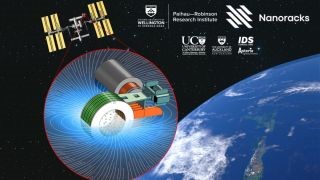Novel Superconducting Magnet Thrusters to be Tested Out on Space Station
 A New Zealand research institute and U.S. commercial firm Nanoracks are combining to send a superconducting magnet technology demonstrator to the International Space Station to test a novel type of space propulsion. The Paihau—Robinson Research Institute intends to test a type of electric space thruster known as applied-field magneto plasma dynamic (AF-MPD) thrusters, which uses high-temperature superconducting (HTS) magnet technology developed by the institute.
A New Zealand research institute and U.S. commercial firm Nanoracks are combining to send a superconducting magnet technology demonstrator to the International Space Station to test a novel type of space propulsion. The Paihau—Robinson Research Institute intends to test a type of electric space thruster known as applied-field magneto plasma dynamic (AF-MPD) thrusters, which uses high-temperature superconducting (HTS) magnet technology developed by the institute.
Superconductors are materials that conduct electricity with zero resistance and therefore with much greater efficiency than conventional conductive materials. Most of these superconductors, however, require temperatures close to the absolute zero (-273 degrees Celsius or - 460 degrees Fahrenheit), which complicates their use. High-temperature superconductors (HTS) can operate at somewhat friendlier temperatures of −321.1 degrees F (−196.2 degrees C), which makes their operations cheaper. On top of that, HTS can generate stronger fields than low-temperature superconductors, have a larger operational range and can be more compact, the Paihau—Robinson Research Institute wrote in a statement.
A New Zealand research institute and U.S. commercial firm Nanoracks are combining to send a superconducting magnet technology demonstrator to the International Space Station to test a novel type of space propulsion. The Paihau—Robinson Research Institute intends to test a type of electric space thruster known as applied-field magneto plasma dynamic (AF-MPD) thrusters, which uses high-temperature superconducting (HTS) magnet technology developed by the institute.
Superconductors are materials that conduct electricity with zero resistance and therefore with much greater efficiency than conventional conductive materials. Most of these superconductors, however, require temperatures close to the absolute zero (-273 degrees Celsius or - 460 degrees Fahrenheit), which complicates their use. High-temperature superconductors (HTS) can operate at somewhat friendlier temperatures of −321.1 degrees F (−196.2 degrees C), which makes their operations cheaper. On top of that, HTS can generate stronger fields than low-temperature superconductors, have a larger operational range and can be more compact, the Paihau—Robinson Research Institute wrote in a statement.
Image: A novel thruster based on a superconducting magnet technology will be tested on the International Space Station. Credit: Victoria University of Wellington


